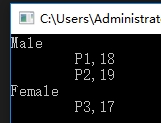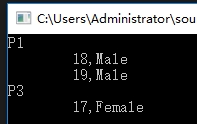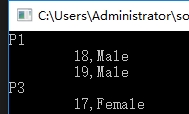[C#] LINQ之GroupBy
声明:本文为www.cnc6.cn原创,转载时请注明出处,谢谢!
本文作者文采欠佳,文字表达等方面不是很好,但实际的代码例子是非常实用的,请作参考。
一、先准备要使用的类:
1、Person类:
class Person
{
public string Name { set; get; }
public int Age { set; get; }
public string Gender { set; get; }
public override string ToString() => Name;
}
2、准备要使用的List,用于分组(GroupBy):
List<Person> personList = new List<Person>
{
new Person
{
Name = "P1", Age = , Gender = "Male" },
new Person
{
Name = "P2", Age = , Gender = "Male",
},
new Person
{
Name = "P2", Age = ,Gender = "Female",
}
};
二、第一种用法:
public static IEnumerable<IGrouping<TKey, TSource>> GroupBy<TSource, TKey>(this IEnumerable<TSource> source, Func<TSource, TKey> keySelector);
官方释义:根据指定的键选择器函数对序列中的元素进行分组。
我们要分组的集合为source,集合内每个元素的类型为TSource,这里第一个参数keySelector的类型为Func<TSource, TKey>,用于将TSource元素按照由此委托返回的类型TKey进行分组,结果为一个已分好组的集合(集合中的集合)。
编写客户端试验代码如下:
var groups = personList.GroupBy(p => p.Gender);
foreach (var group in groups)
{
Console.WriteLine(group.Key);
foreach(var person in group)
{
Console.WriteLine($"\t{person.Name},{person.Age}");
}
}
以上代码指定的KeySelector是Person类的Gender属性,因此,以上会按照Gender(性别)进行分组,我们使用两个嵌套的foreach循环将分组的内容打印到控制台。
因为groups返回的类型为IEnumerable<IGouping<TKey,TSource>>,因此以上返回的类型为IEnumerable<IGouping<string,Person>>。
IGouping<string,Person>是已经分组后的集合,内部集合元素为Person,且IGouping有一个Key属性,类型为string(指的是Gender属性类型),用于分组的标识。
输出结果如下:

其等价的LINQ语句为:
var groups = from p in personList
group p by p.Gender;
以上的意思可以这样理解:从personList取出p,并对p进行分组,使用分组的依据(Key)为p.Gender,并将分组的结果存储到pGroup,并将分组的结果选择出来合并成一个集合。
三、第二种用法:
public static IEnumerable<IGrouping<TKey, TSource>> GroupBy<TSource, TKey>(this IEnumerable<TSource> source, Func<TSource, TKey> keySelector, IEqualityComparer<TKey> comparer);
官方释义:根据指定的键选择器函数对序列中的元素进行分组,并使用指定的比较器对键进行比较。
这种比第一种方法多了一个参数,那就是一个相等比较器,目的是为了当TKey为自定义的类时,GroupBy能根据TKey指定的类根据相等比较器进行分组,
因此,自定义类如何进行分组,GroupBy是不知道的,需要自己定义自己的相等比较器。
首先,将personList更改如下(下划线部分):
List<Person> personList = new List<Person>
{
new Person
{
Name = "P1", Age = , Gender = "Male" },
new Person
{
Name = "P1", Age = , Gender = "Male",
},
new Person
{
Name = "P3", Age = ,Gender = "Female",
}
};
其次,增加一个相等比较器类,用于对Person进行分组:
class PersonEqualityComparer : IEqualityComparer<Person>
{
public bool Equals(Person x, Person y) => x.Name == y.Name;
public int GetHashCode(Person obj) => obj.Name.GetHashCode();
}
其中定义了如何对一个Person相等性定义,只要实现IEqualityComparer<Person>即可,这里以Name作为Person类是否相同的依据。
最后,现在我们对Person类进行分组,编写客户端实验代码如下:
var groups = personList.GroupBy(p => p, new PersonEqualityComparer());
foreach (var group in groups)
{
Console.WriteLine(group.Key.ToString());
foreach(var person in group)
{
Console.WriteLine($"\t{person.Age},{person.Gender}");
}
}
以上的分组依据是Person类,并运用了自己定义的Person类相同比较器,只要Name相同,就分为一组,
输出结果如下:

四、第三种用法:
public static IEnumerable<IGrouping<TKey, TElement>> GroupBy<TSource, TKey, TElement>(this IEnumerable<TSource> source, Func<TSource, TKey> keySelector, Func<TSource, TElement> elementSelector);
官方释义:根据指定的键选择器函数对序列中的元素进行分组,并且通过使用指定的函数对每个组中的元素进行投影。
这个比第一种用法多了一个elementSelector,第一种用法是对集合本身按照TKey分组,并将自己(TSource)添加到分组内,而当前的用法则可以选择自己想要添加到分组内的元素类型。
编写客户端实验代码如下:
var groups = personList.GroupBy(p => p.Gender, p=>p.Name);
foreach (var group in groups)
{
Console.WriteLine(group.Key.ToString());
foreach(var name in group)
{
Console.WriteLine($"\t{name}");
}
}
以上代码是按照p.Gender进行分组,并将p.Name作为组内的元素。
输出结果如下:

其等价的LINQ语句为:
var groups = from p in personList
group p.Name by p.Gender;
五、第四种用法:
public static IEnumerable<TResult> GroupBy<TSource, TKey, TResult>(this IEnumerable<TSource> source, Func<TSource, TKey> keySelector, Func<TKey, IEnumerable<TSource>, TResult> resultSelector);
官方释义:根据指定的键选择器函数对序列中的元素进行分组,并且从每个组及其键中创建结果值。
这个跟之前的用法都不同,之前的用法都是将结果进行分组,并返回IGrouping<TKey,TSource>对象,而当前用法则是返回自己定义的类型(TResult),在返回自己定义类型之前,将会传入两个参数,一个是TKey,为分组时指定的对象,另外一个则是IEnumerable<TSource>,为分组后的内部对象集合。
编写客户端实验代码如下:
string GetPersonInfo(string gender, IEnumerable<Person> persons)
{
string result = $"{gender}:\t";
foreach (var p in persons)
{
result += $"{p.Name},{p.Age}\t";
}
return result;
}
var results = personList.GroupBy(p => p.Gender,(g, ps) => GetPersonInfo(g,ps));
foreach (var result in results)
{
Console.WriteLine(result);
}
GetPersonInfo为局部方法,见于C#7.0及以上。
以上代码将分组后的内容(一个是TKey,为p.Gender,另外一个是IEnumerable<TSource>,为IEnumerable<Person>)作为字符串输出,因此,将返回的类型为字符串集合。
输出结果如下:

其等价的LINQ语句为:
var results = from p in personList
group p by p.Gender into pGroup
select GetPersonInfo(pGroup.Key, pGroup);
六、第五种用法:
public static IEnumerable<IGrouping<TKey, TElement>> GroupBy<TSource, TKey, TElement>(this IEnumerable<TSource> source, Func<TSource, TKey> keySelector, Func<TSource, TElement> elementSelector, IEqualityComparer<TKey> comparer);
官方释义:根据键选择器函数对序列中的元素进行分组。通过使用比较器对键进行比较,并且通过使用指定的函数对每个组的元素进行投影。
与第三种用法基本相同,只是多了一个相等比较器,用于分组的依据。
使用第二种用法的personList及PersonEqualityComparer,编写客户端实验代码如下:
var groups = personList.GroupBy(p => p, p => new { p.Age,p.Gender },new PersonEqualityComparer());
foreach (var group in groups)
{
Console.WriteLine(group.Key.ToString());
foreach (var name in group)
{
Console.WriteLine($"\t{name.Age},{name.Gender}");
}
}
以上代码的分组依据是Person,PersonEqualityComparer则是作为Person分组的比较器,每个组内为一个匿名类型集合。
输出结果如下:

七、第六种用法:
public static IEnumerable<TResult> GroupBy<TSource, TKey, TResult>(this IEnumerable<TSource> source, Func<TSource, TKey> keySelector, Func<TKey, IEnumerable<TSource>, TResult> resultSelector, IEqualityComparer<TKey> comparer);
官方释义:根据指定的键选择器函数对序列中的元素进行分组,并且从每个组及其键中创建结果值。通过使用指定的比较器对键进行比较。
与第四种用法基本相同,只是多了一个相等比较器,用于分组的依据。
使用第二种用法的personList及PersonEqualityComparer,编写客户端实验代码如下:
string GetPersonInfo(Person person, IEnumerable<Person> persons)
{
string result = $"{person.ToString()}:\t";
foreach (var p in persons)
{
result += $"{p.Age},{p.Gender}\t";
}
return result;
}
var results = personList.GroupBy(p => p, (p, ps) => GetPersonInfo(p, ps),new PersonEqualityComparer());
foreach (var result in results)
{
Console.WriteLine(result);
}
以上代码的分组依据是Person,PersonEqualityComparer则是作为Person分组的比较器,每个组内为一个Person集合,并将返回类型为string的字符串输出。
输出结果如下:

八、第七种用法:
public static IEnumerable<TResult> GroupBy<TSource, TKey, TElement, TResult>(this IEnumerable<TSource> source, Func<TSource, TKey> keySelector, Func<TSource, TElement> elementSelector, Func<TKey, IEnumerable<TElement>, TResult> resultSelector);
官方释义:根据指定的键选择器函数对序列中的元素进行分组,并且从每个组及其键中创建结果值。通过使用指定的函数对每个组的元素进行投影。
与第四种方法很类似,只是对分组内的元素进行选择,原有为TSource,现改为TElement。
编写客户端实验代码如下:
string GetPersonInfo(string gender, IEnumerable<string> names)
{
string result = $"{gender}:\t";
foreach (var name in names)
{
result += $"{name}\t";
}
return result;
}
var results = personList.GroupBy(p => p.Gender, (p=>p.Name) ,(g, ns) => GetPersonInfo(g, ns));
foreach (var result in results)
{
Console.WriteLine(result);
}
以上代码将使用Gender分组,并将分组后的信息组合成一条字符串,并输出到控制台。
输出结果如下:

九、第八种用法:
public static IEnumerable<TResult> GroupBy<TSource, TKey, TElement, TResult>(this IEnumerable<TSource> source, Func<TSource, TKey> keySelector, Func<TSource, TElement> elementSelector, Func<TKey, IEnumerable<TElement>, TResult> resultSelector, IEqualityComparer<TKey> comparer);
官方释义: 根据指定的键选择器函数对序列中的元素进行分组,并且从每个组及其键中创建结果值。通过使用指定的比较器对键值进行比较,并且通过使用指定的函数对每个组的元素进行投影。
与第七种用法基本相同,只是多了一个相等比较器,用于分组的依据。
使用第二种用法的personList及PersonEqualityComparer,编写客户端实验代码如下:
var results = personList.GroupBy(p => p, (p=>new { p.Age,p.Gender}),
(p, ns) =>
{
string result = $"{p.ToString()}:\t";
foreach (var n in ns)
{
result += $"{n.Age},{p.Gender}\t";
}
return result;
},new PersonEqualityComparer());
foreach (var result in results)
{
Console.WriteLine(result);
}
以上代码将使用Person分组,使用Person比较器作为分组的依据,并将分组后的信息组合成一条字符串,并输出到控制台。
输出结果如下:

[C#] LINQ之GroupBy的更多相关文章
- Linq Mysql GroupBy语句的问题处理
语句如下: var resumeList = db.ChannelResume.Where(model); var groupValues = resumeList.GroupBy(t => n ...
- linq lambda GroupBy 用法
Linq 中按照多个值进行分组(GroupBy) /// <summary>要查询的对象</summary> class Employee { public int ID ...
- 转载有个小孩跟我说LINQ(重点讲述Linq中GroupBy的原理及用法)
转载原出处: http://www.cnblogs.com/AaronYang/archive/2013/04/02/2994635.html 小孩LINQ系列导航:(一)(二)(三)(四)(五)(六 ...
- 转载Linq中GroupBy方法的使用总结
Group在SQL经常使用,通常是对一个字段或者多个字段分组,求其总和,均值等. Linq中的Groupby方法也有这种功能.具体实现看代码: 假设有如下的一个数据集: public class St ...
- LINQ 之 GroupBy
声明:本文为www.cnc6.cn原创,转载时请注明出处,谢谢! 本文作者文采欠佳,文字表达等方面不是很好,但实际的代码例子是非常实用的,请作参考. 一.先准备要使用的类: 1.Person类: cl ...
- Linq中GroupBy方法的使用总结(转)
Group在SQL经常使用,通常是对一个字段或者多个字段分组,求其总和,均值等. Linq中的Groupby方法也有这种功能.具体实现看代码: 假设有如下的一个数据集: public class St ...
- Linq中GroupBy方法的使用总结(转载)
from:https://www.cnblogs.com/zhouzangood/articles/4565466.html Group在SQL经常使用,通常是对一个字段或者多个字段分组,求其总和,均 ...
- c# linq 分组groupby
转载: https://www.cnblogs.com/cncc/p/9846390.html 一.先准备要使用的类: 1.Person类: class Person { public string ...
- DataTable/Array Linq查询,groupby
DataTable Linq查询 1.查询DataRow IEnumerable<DataRow> q1 = from r in dt.AsEnumerable() == select r ...
随机推荐
- JMeter—总结
Jmter简单总结 简单的使用篇 jmeter简单的使用 Jmeter中默认语言的显示 jmeter利用自身代理录制脚本 Jmeter运行后出现乱码 http cookie管理中cookie poli ...
- 洗礼灵魂,修炼python(87)-- 知识拾遗篇 —— 线程(1)
线程(上) 1.线程含义:一段指令集,也就是一个执行某个程序的代码.不管你执行的是什么,代码量少与多,都会重新翻译为一段指令集.可以理解为轻量级进程 比如,ipconfig,或者, python ...
- Unity的AssetDatabase路径格式
开发环境 windows 7 Unity 5.3 及更高版本 前言 使用AssetDatabase.Load或AnimatorController.CreateAnimatorControllerAt ...
- Syntax error, parameterized types are only available if source level is 1.5 解决方案
在网上找了一个K-means算法的程序,打开,运行,出现了Syntax error,parameterized types are only available if source level is ...
- GitHub-暂存区与版本回退
参考博文:廖雪峰Git教程 1. 工作区和暂存区 Git和其他版本控制系统如SVN的一个不同之处就是有暂存区的概念. 1.1. 工作区(Working Directory) 就是你在电脑里能看到的目录 ...
- MATLAB简易画图
给定一组特殊点,连线作图 作者:凯鲁嘎吉 - 博客园 http://www.cnblogs.com/kailugaji/ 以成绩隶属函数为例: score.m cj_x1=[ 0.1]; cj_y1= ...
- ABAP on HANA之CDS Association和Path Expression
本文阐述了ABAP CDS association的概念,并且展示了在CDS视图中和SQL语句中写路径表达式(Path Expression)代码的方法.我也会解释如何在CDS asociation中 ...
- Angular之模态弹窗ui-bootstrap-modal及轻量级弹窗ngDialog
ui-bootstrap 中模态 官网 angular-ui-bootstrap 对于ui-bootstrap集成大量指令如折叠ui.bootstrap.accordion.时间插件ui.boot ...
- 《Java大学教程》--第3章 迭代
迭代(iteration).重复(repetition):三种循环* for: 重复执行固定次数* while: 重复执行不固定次数* do...while: 比while至少多一次 1.答:P47迭 ...
- A - 畅通工程续 最短路
某省自从实行了很多年的畅通工程计划后,终于修建了很多路.不过路多了也不好,每次要从一个城镇到另一个城镇时,都有许多种道路方案可以选择,而某些方案要比另一些方案行走的距离要短很多.这让行人很困扰. 现在 ...
